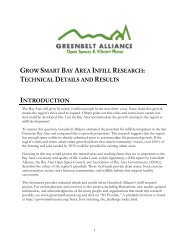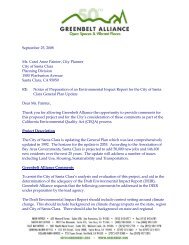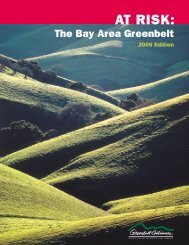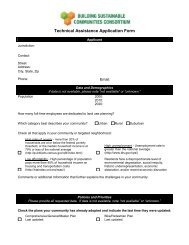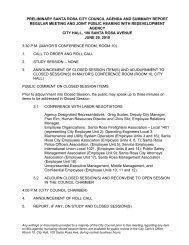Morgan Hill Agricultural Policies and Implementation Program
Morgan Hill Agricultural Policies and Implementation Program
Morgan Hill Agricultural Policies and Implementation Program
You also want an ePaper? Increase the reach of your titles
YUMPU automatically turns print PDFs into web optimized ePapers that Google loves.
<strong>Morgan</strong> <strong>Hill</strong> City Council's Action<br />
The <strong>Morgan</strong> <strong>Hill</strong> City Council considered <strong>and</strong> accepted the planning commission's recommendations<br />
at its meeting on April 30, 2008. The City Council directed staff to prepare an environmental impact<br />
report (EIR) to analyze the proposed SEQ l<strong>and</strong> use amendments <strong>and</strong> agricultural policies, evaluating<br />
both alternatives at the same level of detail. In addition, the council directed staff to develop<br />
additional information about the feasibility of agricultural mitigation <strong>and</strong> the long-term viability of<br />
agricultural l<strong>and</strong>s within the <strong>Morgan</strong> <strong>Hill</strong> SOI. On April 7, 2010, the City Council accepted a refined<br />
project description for the purposes of the EIR that combines the two alternatives into one l<strong>and</strong> use<br />
plan <strong>and</strong> is based on the premise that small-scale agriculture, under certain circumstances, is viable<br />
within the <strong>Morgan</strong> <strong>Hill</strong> SOI.<br />
California Environmental Quality Act M<strong>and</strong>ate<br />
A key motivation for this study comes from the California Environmental Quality Act (CEQA). For<br />
development projects that fall under the domain of CEQA, the statute requires that impacts to<br />
agricultural resources (farml<strong>and</strong>) <strong>and</strong> open space be considered <strong>and</strong>, if feasible, mitigated. The 2010<br />
CEQA guidebook, page 243, offers the following guidance for determining whether a proposed<br />
project impacts agricultural resources:<br />
Would the project:<br />
1. Convert Prime Farml<strong>and</strong>, Unique Farml<strong>and</strong>, or Farml<strong>and</strong> of Statewide Importance (Farml<strong>and</strong>) as<br />
shown on maps prepared pursuant to the Farml<strong>and</strong> Mapping <strong>and</strong> Monitoring <strong>Program</strong> of the<br />
California Resources Agency, to non-agricultural use<br />
2. Conflict with existing zoning for agricultural use, or a Williamson act contract<br />
3. Involve other changes in the existing environment which, due to their location or nature, could<br />
result in the conversion of Farml<strong>and</strong> to non-agricultural use<br />
No specific threshold of significance for impact to agricultural resources is stipulated by CEQA—the<br />
determination of what level of impact is significant is determined by local policies. In undertaking<br />
this study, <strong>Morgan</strong> <strong>Hill</strong> seeks to formally define the significance of impacts to agricultural resources<br />
by proposed projects <strong>and</strong> appropriate means of mitigating such impacts.<br />
A-2 P:\19000s\19014<strong>Morgan</strong><strong>Hill</strong>\Report\MHAgReport_22Dec2011_Public_Review.doc




